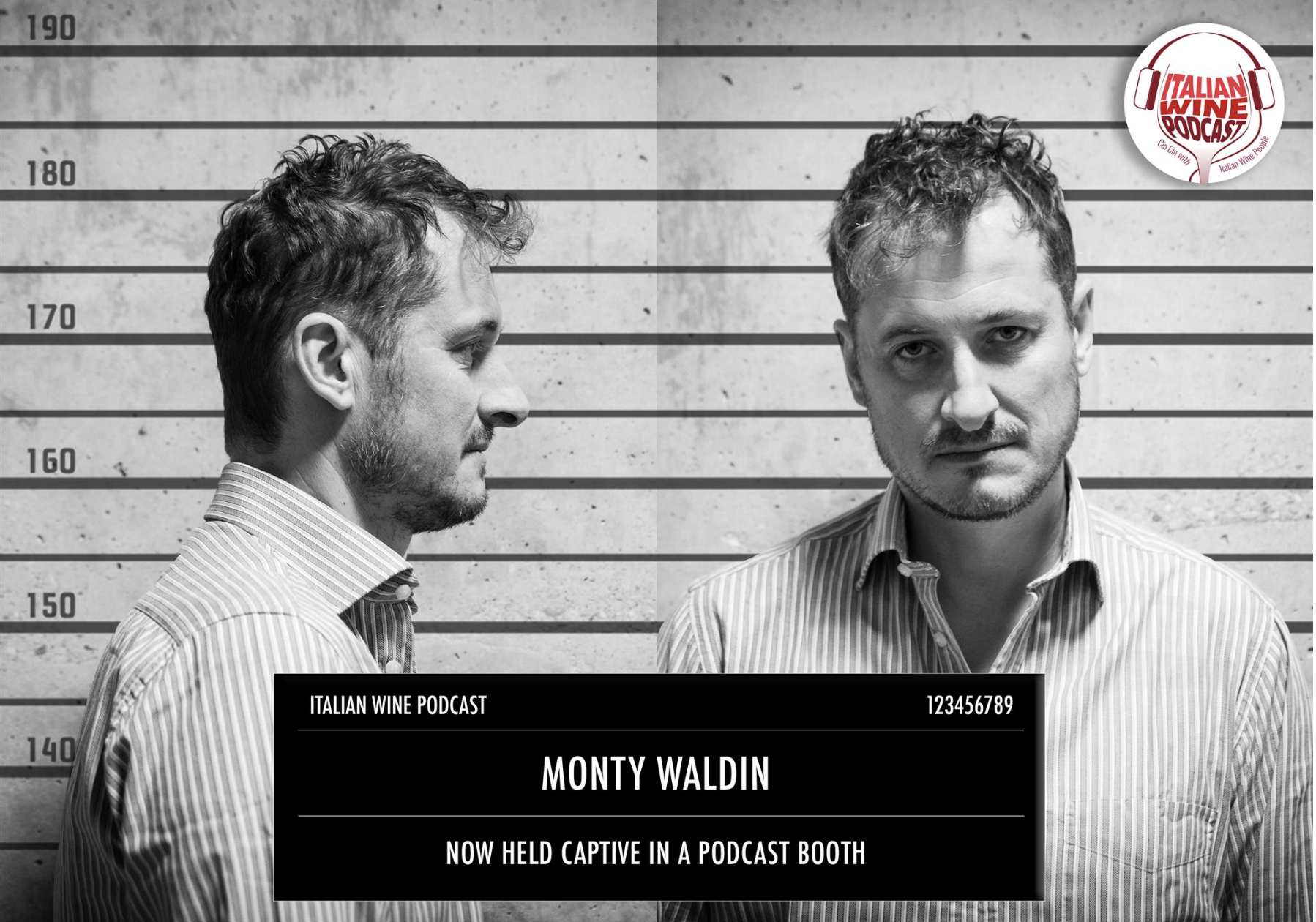
Organic and biodynamic wines are currently a very hot topic in fashionable wine circles. Grape Collective talks to Monty Waldin, a writer who was swimming against the current in the 1990s and 2000s promoting these concepts at a time when overly-extracted, highly-manipulated wine was what was garnering all the critical attention.
Monty Waldin's immersion into wine started as a teenager while working on Bordeaux vineyards which he visited to improve his French in the mid-1980s. He caught the wine bug and started traveling around the world to work in organic and then biodynamic estates, and wrote the first books on both organic and biodynamic wines and winemaking. Waldin won a James Beard award for Best Wine Book 2007-2008 for his wines of South America book and starred in a British television documentary called Château Monty focused around converting a vineyard in France to biodynamics.
Waldin is currently the host of the Italian Wine Podcast - check it out on Soundcloud and iTunes.
Grape Collective talks with Waldin discussing the evolution of winemaking in Tuscany and biodynamics.
Christopher Barnes: Is organics important because it's a stamp, or a category, on a wine store shelf, or is it important because you make better wine?
(Photo of Monty Waldin courtesy of The Italian Wine Podcast)
Monty Waldin: Well I think, probably, when organics was getting going about, say, 20 years ago, there was a bit of a war, if you like, between wines, products, labeled as organic saying they're better than conventional products, and I think we've got out of that phase now. I think most wine growers, or even olive growers or farmers in general that you speak to, saying that we do it for quality, organics gives us ... it makes farming more predictable, actually; by looking after your soil your soil drains better, so if it's very hot or very wet the soil can absorb the heat and absorb the wetness, which means that your plants or your vines or your grain or your olives, or whatever it is that you're growing, can react better to climatic events.
We're getting, obviously, some weird climatic weather at the moment, global weirding, as it's called, your vines become more resistant if they're not being fed antibiotics, if you like, they can fend for themselves, and by fending for themselves they're more interesting as individuals and, by being more interesting as individuals, your vines are growing to produce more interesting grapes, which should make for more interesting wine.
And organics is one step, but biodynamics is one step further; what does biodynamics mean?
Well, the three pillars of biodynamics, the main thing is you're trying to make every single vineyard of farm a self-sustaining living organism, and what that means is you're trying to minimize inputs, you're trying to minimize the number of invoices you send for stuff that's being brought into your vineyard off the farm, so it could be weedkillers to deal with weeds, or pesticides, or fungicides, or fertilizers; what you're trying to do is create this cycle of fertility on your estate. And in Tuscany it's fairly easy to have some other animals, they could be some cows or sheep or pigs, and the idea there is you're going to compost their manure and compost any green waste that your winery produces, which, at the end of the day after making wine, you'll be left with some pips, the grape pips, and some grape seeds, you can compost all that and put it back in the vineyard. So you're not actually buying in any fertility, you're trying to create, as I said, this self-sustaining living organism. 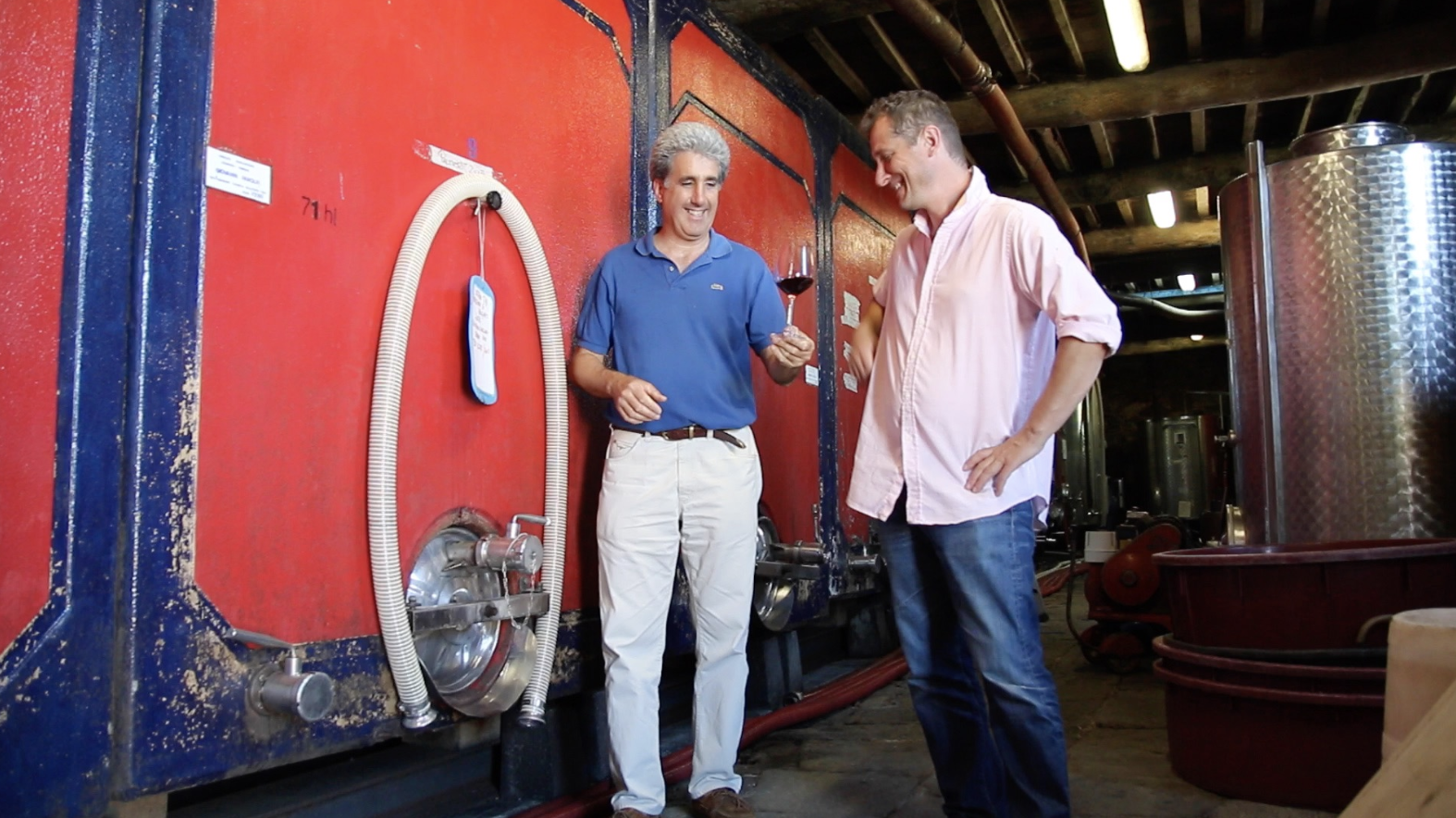 (Photo Monty Waldin with biodynamic pioneer Saverio Petrilli in Luca, Italy)
(Photo Monty Waldin with biodynamic pioneer Saverio Petrilli in Luca, Italy)
The other thing you're trying to do with biodynamics is reconnect yourself, but mainly your vines and your plants, with celestial cycles. I know that sounds a little bit crazy, but obviously the key celestial cycle that we are influenced by is the sun, without the sun we're not here, so we have the 365-day year, we have four seasons, we also have lunar cycles that can vary in length between around about 27 days and 31 days. Just trying to get your vineyard to tune into those subtleties that are around you in what's called the celestial cycle; the moon, the stars and the planets. Again, it sounds a little bit weird but it doesn't actually cost you any money to work with lunar cycles, so I say, listen, if you believe it or don't believe that it has any effect on the grapes or yourself, that's absolutely fine, but it's not doing anybody any harm and if you want to do that, why not?
And the third thing about biodynamics, which is probably the hardest thing to grasp, is that what you're trying to do is you're trying to create or grow food, or in this case wine, that's good not just for your body in terms of not having any chemicals in it, but in terms of vitamins and minerals and things like that, something that's good for your body as well as for your spirit. It doesn't mean that if you drink or eat a biodynamic product, biodynamic milk or wine or biodynamic bread, that you're suddenly going to start running off to church, the idea is that you develop a spiritual connection with the natural world around you. It just means that you're really in tune with your animals, with your plants, with your wine, how your wine tastes, what it's doing in the winery, and the idea there is that you're going to make a wine on a vineyard where everything is in tune; you're in tune with your grapes, the grapes are in tune with the soil, the soil is in tune with celestial and other cycles, and you're basically trying to create something that's really harmonious. And, ultimately, you should deliver your product that's good, that tastes good and that makes you feel good.
Chianti Classico, how has it evolved as a region?
Chianti Classico is one of the historic regions in Italy. It was first demarcated in the early 1700s. That brings opportunities and challenges. Opportunity, obviously, with an historic wine region wine is always married to its kind of sense of history.
In the modern era, administratively at least I think, Chianti's got itself into a little bit of a muddle. I think there are about 19 different types of Chianti, and 19 different ways of labeling a bottle of Chianti. It can be Chianti Classico, just Chianti, Chianti Riserva, Chianti Superiore, Chianti Rufina, Chianti Colline Pisane from the Pisa Hills, or from the Siena hills. It's a real mess. It's very, very difficult for consumers to pick their way through that. And I think at the moment in terms of the administrative evolution of Chianti we've hit a bit of a brick wall, and that is encouraging producers to think outside the box.
And what do I mean by that? Well, in Chianti Classico you've got a couple of subregions that are turning themselves into what are called bio-distretti or bio-districts, or environmental zones in which all of the farmers, not just the wine growers, are trying to become more ecologically aware, and they're doing that partly because it saves money, but also because of better quality. That's one way they're demarcating themselves by saying, "Our products ... It's a Chianti product, but we're making it a little bit differently to how we used to. We're not using the chemical fertilizers and the weed killers, and we want you to hear about that. Well, we think that's important, and we think you as a visitor to the region, as tourists to the region, or as wine bars in far off markets it's important for you to know that we work with nature rather than against nature." That's one way Chianti is evolving on the production side.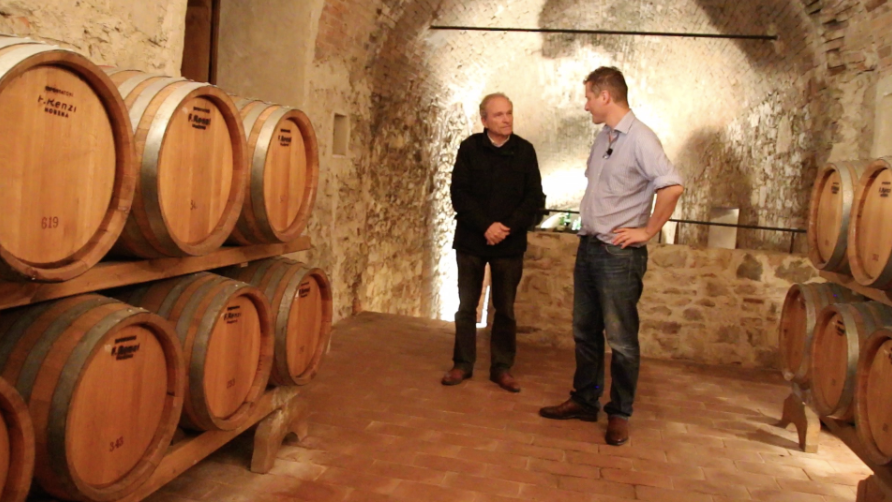
(Giuseppe Mazzocolin of Fattoria di Fèlsina with Monty Waldin in Chianti Classico, Tuscany)
The other main discussion happening in Chianti Classico at the moment is called zoning. And it's not a very nice word, zoning, but effectively what it means is the historic zone between the cities of Florence and Siena, which is the Classico zone, is supposed to produce the best wine, and it does, generally, produce the best Chianti Classico. But there are various villages, or towns, or townships, in the Chianti region apart from Florence or Siena, obviously, which demarcate the northern and southern boundaries, respectively.
And what producers there are saying is actually, "Our vineyards are in the communal, the village of Greve in Chianti, for example. Or in the little sub-village of Panzano in Chianti. And we want to divide the Chianti's up in these little micro-terras, or micro-zones, or micro-regions to better communicate why our particular Chianti Classico from this particular area tastes the way it does. It might be a little bit more spicy. It might be slightly darker in color, if it's a warmer area. The red fruit flavors may be slightly more mentholated or minty in a higher area where it's a little bit cooler." And they think that's the way to make Chianti interesting again, by breaking it down into its constituent parts a little bit like the Burgundians did a thousand years ago when the monks demarcated every single field, and gave each one of them a name so that the grapes that came from that particular field would taste a little bit different than the one from next door on this side, or further up the hill, or lower down the hill.
Again, wine loves to complicate matters. But in this case it may be quite useful to break Chianti Classico down into its constituent parts, and rebuild things back from the base.
Chianti has had some marketing challenges. Chianti is known for inexpensive wine, there are big producers that kind of flooded the market with this, and people, in their mind, thought Chianti, cheap wine. But there are some interesting producers making more artisanal wines. How is that dynamic?
The dynamic is probably an intractable one. I would say you have, on the one hand, to keep it simple, Chianti and Chianti Classico.
Chianti can come from anywhere in a very large area outside of Florence and Siena, and because it's not quite as famous as Chianti Classico the price is for the lower, and that has attracted merchants or big bottlers and they, generally, don't own all of their vineyards. They buy in grapes for a set price. And the people growing those grapes the motivation for them is what? Is it to go for quality or go for volume, and they grow as many grapes as they could. Often the grapes don't have such concentrated flavors, and maybe not fully ripe, and the result is you get Chianti that can really drastically vary in quality. 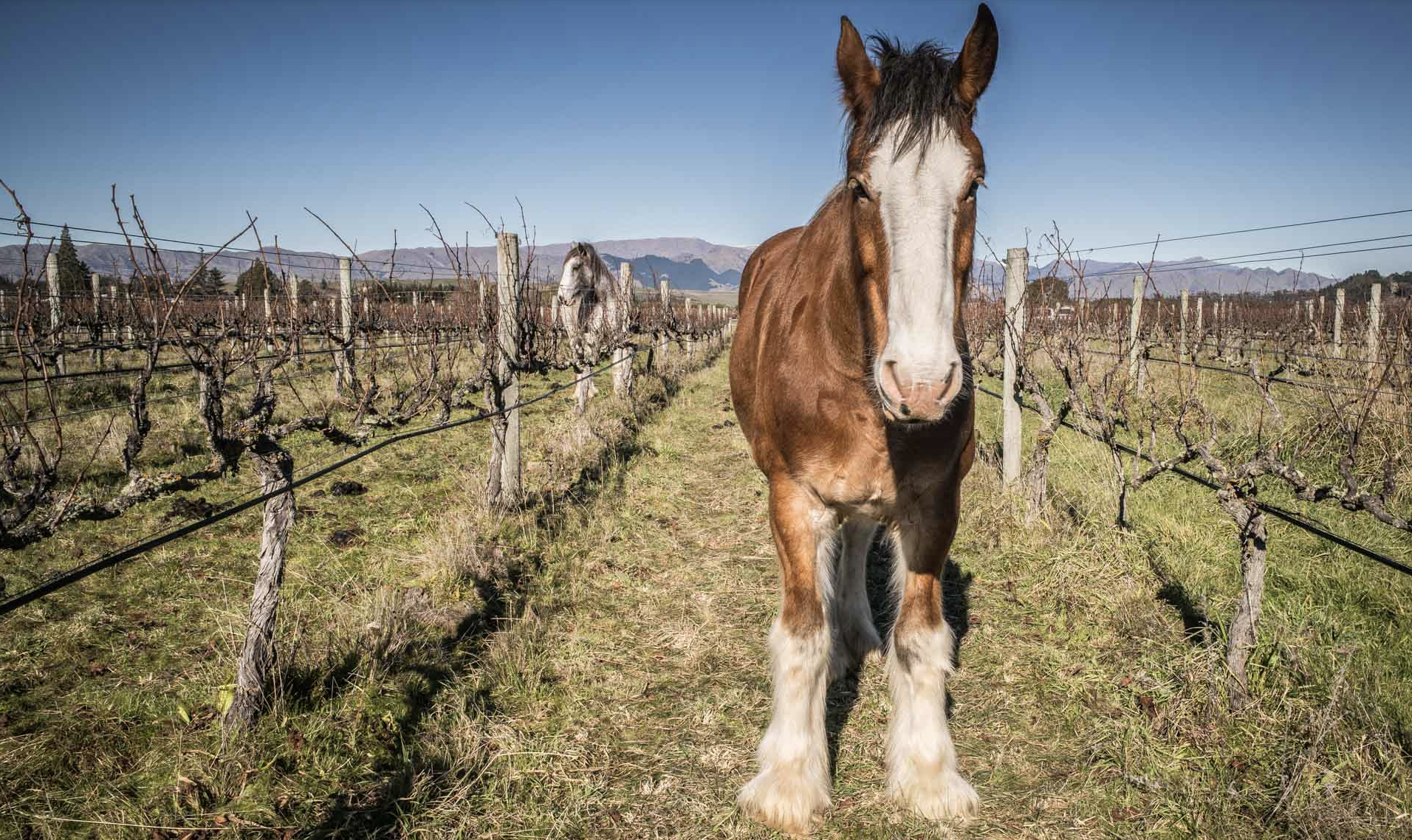
(Gracie and Bill - biodynamic helpers at the Seresin Estate in New Zealand photo by Monty Waldin - check out his photography here)
When it's good it's a fantastic wine. It's a great fruit wine, it's a good lunchtime wine, it's not too heavy, it's nice and fluid, nice and fruity. At it's worst it's pretty uninteresting as a product. It's like why would you bother to call this Chianti? It's not a very interesting wine, it's no different from lots of other red wines.
But the problem is that these big merchants, who really control the market, can set the price, and that means that with the price of Chianti staying very, very low it's very hard for anybody to say, "Actually, I'm going to lower my yields and have less grapes per vine, which means less bottles of wine per square meter, and I only go for quality." Basically it means that you're going to throw money out of the window, because it's very hard for you to say, "Actually my Chianti is twice the price of a supermarket Chianti, or three times the price of a supermarket Chianti. Really you should try it. It's really good. It's a little bit more concentrated, a bit ripe, a bit more interesting." It's very hard to convince consumers to say, "Actually, you know what? I'm going to pay three times as much money as I would for a supermarket Chianti, and take a risk on yours when wine is already so complicated."
(Winemaker Sean O'Callaghan of Riecine in Chianti Classico with Monty Waldin)
It's almost an intractable problem, I would say.
So, Chianti is a pretty big area, right? How big is Chianti?
How big is Chianti? So, whenever we say Chianti, we've got to be specific. When we say Chianti we mean Chianti Classico, the classic zone between Florence and Siena, plus all the other vineyards around that area. So, when we say Chianti we mean the whole area. How big is Chianti? It's too big. That's the answer.
And there are some artisanal producers in Chianti who are raising the level of the game there?
There are. I mean, there are some artisanal producers in Chianti, and their estates work but do not grow. It's the people that actually own their own land, and the grapes that they farm they turn into wine themselves, which means that they're called estate wine groves. They bottle the grapes, so they don't sell them to big merchants, they don't buy in grapes from somewhere else, or they don't buy wine bottled from somewhere else. And those farms, generally, can remain economically successful. It's not just because of their wine though, they may have other crops. They may have olives, they may have grains, and they may call themselves agritourisma, or agritourisms, which means accommodation. Maybe a bed and breakfast, or a couple of rooms for rent, or even a little farm house to rent on the property itself, and they derive extra income from that ancillary activity. And that helps them to stay afloat economically.
So, that's one reason it's very hard to look at entity, particularly, in Chianti. Take a look at the wine in isolation you are unlikely to find artisanal wines, or handcrafted, handmade wines of high quality from the big merchants, because all they're interested in is volume. They just want to buy as many grapes as they can at the lowest price possible, and churn this wine out as quickly as they can, so they're getting their cash back.
But there are few artisanal Chiantis, and increasing less because it's very, very difficult. Unless, as I said, you're attracting foreigners to your farm, and you can sort of hand sell your wine, and they go back to the country they live in, and word of mouth gets around. And you can maintain a decent economic price of your wine. But, again, you're also relying on extra income on say your olives, and also from your tourism, even a restaurant on the property itself.
How easy is it to be organic in Tuscany?
Well, statistically, Tuscany is one of the leading regions in Italy for its organic surface area, not just for wine but for other crops as well. It's got a very good climate, you have what you need to be successful organically, to make life easy for yourself in terms of controlling diseases which can affect the grapes. You want to have a lot of sun, which Tuscany has, you want to have rain at the right time, which Tuscany generally gets in spring and autumn, and you want to have good air flow, it's important that the air is always moving through the vineyard, and that just keeps diseases at bay. And Tuscany is well placed because it's got some cool mountains on one side and a warm sea on the other, so the air is always moving, basically.
One of the reasons why Tuscany has such a high percentage of organic growers, apart from the fact that it's a pretty easy place to be organic, is in the '70s, or late '60s and '70s, when Tuscany, or Italy in general, underwent a bit of a revolution in terms of how the land was divided up between landowners and small farmers. You had an influx of foreign buyers looking for lovely farmhouses to restore, those farmhouses often came with land, olive groves and vineyards, and the kind of lifestyle and mentality meant that whether you were a German or a Brit or an American buying a vineyard there, or even someone from another region in Sicily, a lot of Sicilians, people from Naples came up and bought vineyards in Tuscany, the lifestyle ethos meant that, well, if we're going to live in the house and have a little vineyard around us with our kids growing up, we don't really want to be spraying too much that's not environmentally friendly.
So that was one impetus for the organic movement in Tuscany, it's the fact that it's easy to do it, it's a nice thing to do, it makes sense if you're marketing a Tuscan product, "Hey, we live in a beautiful place." If you say, "Hey, we live in a beautiful place, but we're spraying lots of chemicals," it doesn't really make sense. "Hey, we're living in a beautiful place, and we're farming it beautifully and we're making beautiful products," that all adds value and it adds up as a proposition for consumers.
How has Montalcino evolved? Brunello has become this world famous wine, but it's a fairly recent phenomena, the stature and the prices that the wine have been getting internationally. How did that happen?
Yes, Brunello has become one of the wine world's icons, and that's interesting just from a global perspective because normally we think of the great global icons as coming from France, obviously, and California in the '70s as well. You know, France like Bordeaux, Burgundy, Champagne, in California we think of Napa Valley, we think of Sonoma, and Italy was previously really known for big brands like Asti Spumante and Chianti, which were kind of everyday wines, they were big volume, everyday wines that you wouldn't ... you'd have a glass with your dinner but you wouldn't really rave about them or think about them as high value, high premium products. And Brunello has metamorphosed over the last 20 or 30 years from being a very desolate village, a bit of a sleepy backwater in the southwest of Tuscany to become a global leader, or the global leader in a red wine made from a grape called Sangiovese, that everybody called Brunello because it's especially small and dark, gives especially small, dark berries and concentrated wine. 
(Montalcino winemaker Francesca Padovani photo by Monty Waldin)
And there are several reasons why Brunello has become, I think, famous. One is it's a nice name, it's an easy name to say, Brunello, there's not a great degree of difficulty in pronouncing the word Brunello. Another thing is it's from a single grape, which makes life easy, it's from the Sangiovese grape, so we know about Chardonnay, it's a white wine, we know about Pinot Noir, it's a red wine, Merlot is a red wine, Brunello, it's a red wine, it's a very easy proposition for consumers to get and for sommeliers to explain, or people in wine stores to explain to customers.
And obviously the main reason it's become well known is because of high quality. Montalcino has a very special terroir or geographic sense, it's in southwest Tuscany, it's in a warm area but it gets cool influences so the grapes can produce two things, they can become nice and concentrated in terms of flavor, and they can give off this wonderful perfume, normally based on red fruit flavors, because of the influence of various factors; where the ocean is, the height of Montalcino, it's especially high, it's quite cool, getting this warm air from the sea and cool air from the mountains on the other side. There's a big volcano that's extinct, it's the highest peak in this part of Tuscany, which kind of blocks cold air and rain coming in from the east, so it's in a very, very privileged position.
And the other thing, I think, that makes Montalcino interesting for wine people like me is, within Montalcino itself, every vineyard is different, and Sangiovese is a wonderful grape, or Brunello grape is a wonderful grape at transmitting a sense of taste, a sense of place, from each little plot of vines that it comes from. So a plot on dark soil, a plot on light colored soil, a plot of Sangiovese vines at high altitude, at middle altitude, low altitude, each one will taste different, no two will taste the same, and that makes for a fascinating backstory for the media to talk about and it makes it fascinating, and sometimes frustrating, for consumers looking to eke out these subtle differences. All the Brunello wines taste of Sangiovese, but all of them are a little bit different.
And since Brunello became famous the community has gone from one of basically local farmers to international companies and wealthy people; how do you feel that has changed the community?
Well, obviously we often paint the big company as the bad guy, in Brunello's case it did actually ... without the help of a larger company called Banfi, which is American owned, it's an American family, the Banfi family, when they came and invested in Montalcino in the early '70s they effectively put Brunello on the world map. Brunello was already well known because of a famous local family called the Biondi Santi, they produced the first Brunello around about 130 years ago at the end of the 19th century. But it was really getting some international distribution for Brunello for the 1970s and '80s onwards, thanks to Banfi ... was one company, there were other investors, the Cinzano family, the Cinzano liqueur family, they also invested there from the north of Italy. It allowed Brunello to reach international markets, because beforehand there were small farmers, as you said, without much volume, without much wine to sell, and, to enjoy global success, generally, you need to have a fair bit of wine to put onto the market.
What happened in the 1990s, there was a sort of stampede of producers, partly helped by European Union regulations which were giving money to people who wanted to get into wine, that wanted to becomes farmers, that brought a whole new group of second generation ... maybe they were lawyers or they were solicitors, they made a bit of money, they wanted to become farmers; helped by a little bit of money from the European Union, and they set themselves up in Montalcino. So then you had a mix of lots of small producers, some traditional producers like Biondi Santi and others who worked locally from the area, and some international producers, you had a real mix of ... you had the perfect mix, the perfect storm, if you like of big volume producers, smaller volume ones, niche producers, all contributing to the Brunello mix. And that makes it, as I said, fascinating for people, also a little bit complicated and complex. 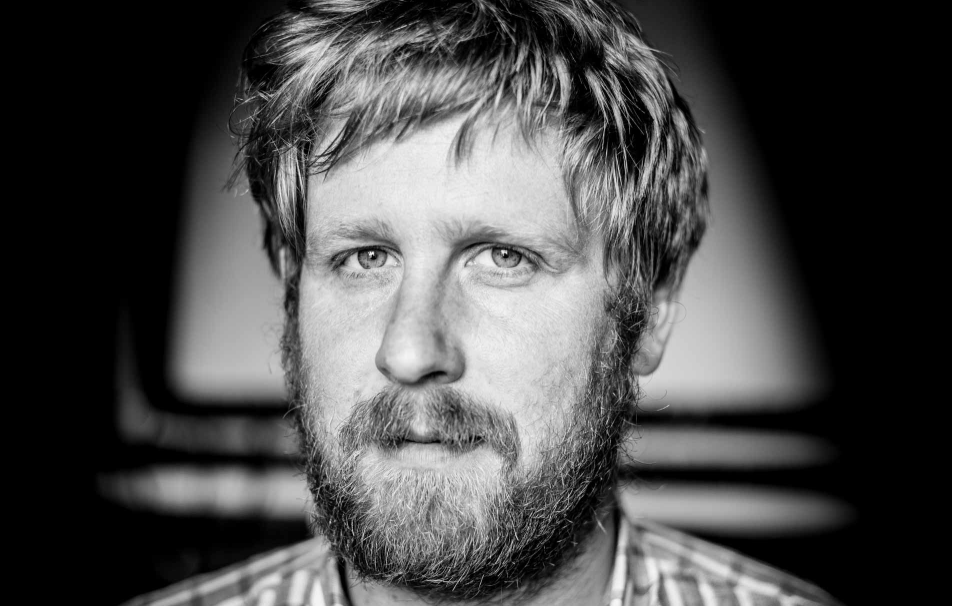
(Montalcino winemaker Fabian Schwarz photo by Monty Waldin)
The risk, and in fact the danger, the trap that Brunello fell into was believing a little bit of its own hype in the mid-2000s when Brunello was really becoming a cult wine. The temptation there was to please international markets by trying to ape other regions, Bordeaux, for example, by making wines that were very powerful, a little bit atypical, getting away from that Sangiovese-ness, if you like. And there were one or two problems with the authorities, the suspicion was that some Brunello producers were adding other grapes to their Brunello, other grapes to their Sangiovese, say Cabernet Sauvignon, or Merlot, which are Bordeaux grapes, and Syrah, which is a Rhône grape, one or two people got their bottoms spanked for doing that.
But, in actual fact, what happened at the end of this scandal, it was called Brunellopoli at the time, was that it was a real wake-up call and what we now find in modern Brunello, contemporary Brunello, is it's the best it's ever been. You have more people making higher quality wine in this region than ever before, you have some fantastic growers, even the big growers, the small growers, the medium growers, all of them are capable of producing a high quality, all of them are really much better farmers than they were even 10 years ago. And that's not just because there's been a big move to organics and biodynamics in the region, people are much more attentive now, about their wine growing, about the grape growing side of things, they're much more attentive in the winery, the trend is to make wines that are easier to drink, that are less powerful, that are less big, that are less muscular, that are less alcoholic, wines are a little bit more refined than they used to be, they're crunchier than they used to be, they're more refreshing than they used to be, they're much better with food than they used to be, they're much more interesting than they used to be, they're much more typical than they used to be.
I'm not saying they're all like this, but in general the level in quality between when I first came here 10 years ago and today, it's about 180 degrees, it's undergone a massive change for the better. There's still work to do but I'm very, very optimistic, I really am optimistic for Brunello.
And there were two camps at one point, I don't know if that's still the case, but there were the traditionalists and then the modernists; what were they doing?
Yeah, traditional versus modern. I'm not sure that there was a really clear dividing line between traditionalists and modernists, you could divide the traditionalists into two sets of traditionalists; the traditionalists that made wine like their grandfather did, which would have been vinegary, dry, rasping, green, lacking fruit, really tough to drink, or the traditionalists which respected the best of the Brunello traditions and produced these silky, balletic, aromatic, refreshing, clear, pure wines that were intense but not heavy. And in the modernist camp, on the bad side, you could have people imitating Bordeaux, so these very dark wines full of black fruit, whereas Sangiovese Brunello really is more of a red fruit wine. Toasty flavors, vanilla flavors from the wood, really concentrated, high in alcohol, high in extract, very tannic, mouth-filling but ultimately quite hard to drink a whole bottle. That's the bad modernist side, and the good modernist side would be wine growers saying, "Actually, we know what we'd like. We like these silky smooth wines with a little twist of oak to them, but we don't want to make wines that are incredibly heavy and incredibly difficult to drink, we want wines that look smart and taste smart in smart restaurants where people can finish the bottle, say that was good, I might order another one."
And I think the last question is Vino Nobile di Montepulciano; how has that region evolved? It sits sort of in the shadow of Brunello and, going back years and years, it was a very successful wine. Today, relative to its neighbors, it is less successful; what is the story with Vino Nobile di Montepulciano?
Yes, Vino Nobile di Montepulciano is probably the sleeping giant in Tuscan wine, it's a very famous brand, as you said, it was called Nobile because the noble families in the 16th century thought very, very highly of it. It was called a wine for nobles, or a wine for noblemen, they didn't say anything about noblewomen, unfortunately, but that's what was written in the ancient texts. Possibly one confusion that people have about Vino Nobile is you are allowed to add French, normally Bordeaux, grapes, but also Syrah to the blend. If you want to make 100% Sangiovese wine you can, but generally Vino Nobile, the wines are mainly Sangiovese with a little seasoning of French grapes. 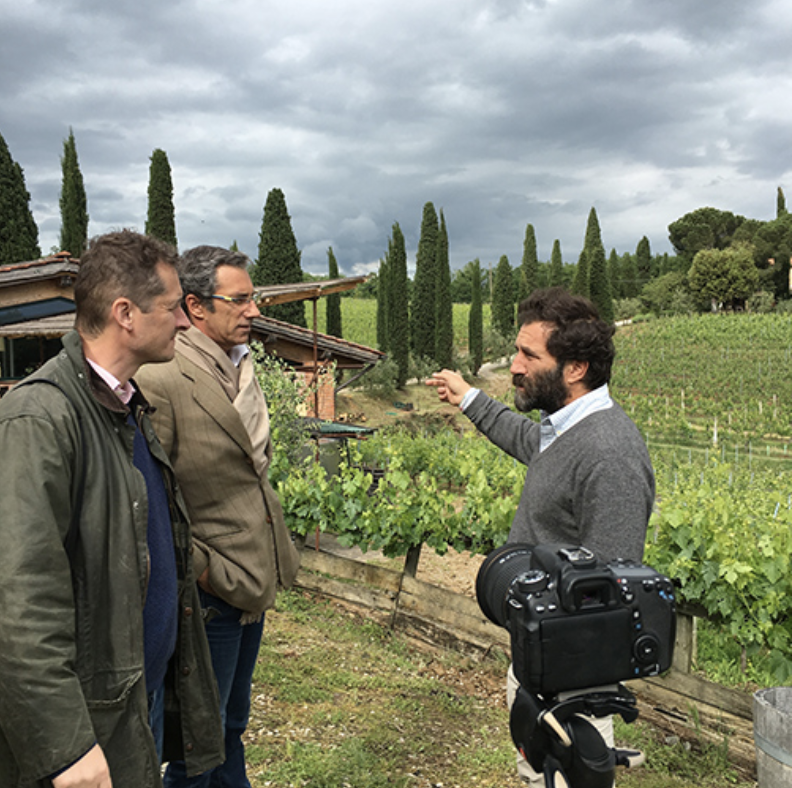
(Monty Waldin with Luca and Nicolò De Ferrari in Montepulciano)
I think possibly what happens with Vino Nobile in the past is the wines were quite traditional, but in the good sense, Vino Nobile has a shorter growing season that Montalcino, which means you get wines which, generally, are not quite as aromatic, maybe not quite as elegant in some ways, they're bigger on the mid-palate, they're very good with food. They do take a little time to understand, a little time to unwind in the bottle, and by adding the French grapes to the Sangiovese, that was probably a sensible decision, in a way, because it added a little bit more silkiness, in the best cases, to those wines. I think there's probably always been a bit of confusion in people's minds, A, stylistically, because of that, because it could taste very much of Tuscany, 100% Sangiovese Vino Nobile, or it could taste of Bordeaux quite legally, unlike in Montalcino, with the French influence.
The other confusion that exists around Vino Nobile di Montepulciano, to give it its full title, is this one comes from the town of Montepulciano in central Tuscany; not too far away, on the other side of Italy on the coast, there's a wine grape called Montepulciano, in Abruzzo it's called Montepulciano D'Abruzzo, so the Montepulciano grape from the region of Abruzzo, whereas Vino Nobile di Montepulciano is the noble wine of the town of Montepulciano, made of Sangiovese, which is completely different, it's priced differently. And that really is very confusing for consumers, especially since Montepulciano D'Abruzzo, the Montepulciano grape from coastal Italy in the Abruzzo region is around about ... it's either the second or third biggest seller in Italy for quality wines. Quality wines means DOC or DOCGY wines and IGT wines. So there's a huge, massive Montepulciano D'Abruzzo on the market, which is generally not priced high, shall we say, I'm not going to say cheap but not priced high, and Vino Nobile Di Montepulciano, which is from a completely different place, Tuscany, completely different blend, completely different wine, and generally much higher prices.
It's incredibly difficult for consumers to get around that problem, and really the only way I would see around that if I was a Vino Nobile producer would be to try and make my message simple about what Vino Nobile is, and, if it was me, I would take away the French influence in Vino Nobile, even though it's been historically a tradition there, and just make my wine from Sangiovese. That's what I would do.
Read Monty Waldin on Hipster Somms and Why Black Magic Wine is Delicious Wine.
More Monty Waldin on Grape Collective.
The Italian Wine Podcast - check it out on Soundcloud and iTunes.
Monty Waldin was the first wine writer to specialize in green issues. He is the author of multiple books, including The Organic Wine Guide (Thorsons, 1999); Biodynamic Wines (Mitchell Beazley, 2004); Wines of South America (Mitchell Beazley, 2003), winner of America’s prestigious James Beard Book Award; Discovering Wine Country: Bordeaux (2005) and Discovering Wine Country: Tuscany (2006), both Mitchell Beazley; and Château Monty (Portico, 2008). Monty has contributed on topics of organic and Biodynamic wine to Hugh Johnson’s Pocket Wine Guide, Tom Stevenson’s Wine Report and he wrote the entries for Biodynamics and organics in The Oxford Companion to Wine (2015; 2006). He has also contributed to BBC radio and TV, numerous British newspapers and websites, as well as to wine, travel and environmental publications including Decanter, World of Fine Wine, The Ecologist, Star & Furrow (journal of the Biodynamic Agricultural Association, UK) and Biodynamics (journal of the Biodynamic Farming & Gardening Association, USA). His most recent books are Monty Waldin’s Best Biodynamic Wines (Floris, 2013) for wine drinkers, Biodynamic Gardening (Dorling Kindersley, 2014) for biodynamic home gardeners, and Biodynamic Wine (2016, Infinite Ideas Oxford), the comprehensive how-to guide for biodynamic wine-growers and students of biodynamic wine.
https://www.amazon.com/Monty-Waldin/e/B001K8EIVS
Banner by Piers Parlett, photograph courtesy of Italian Wine Podcast.














